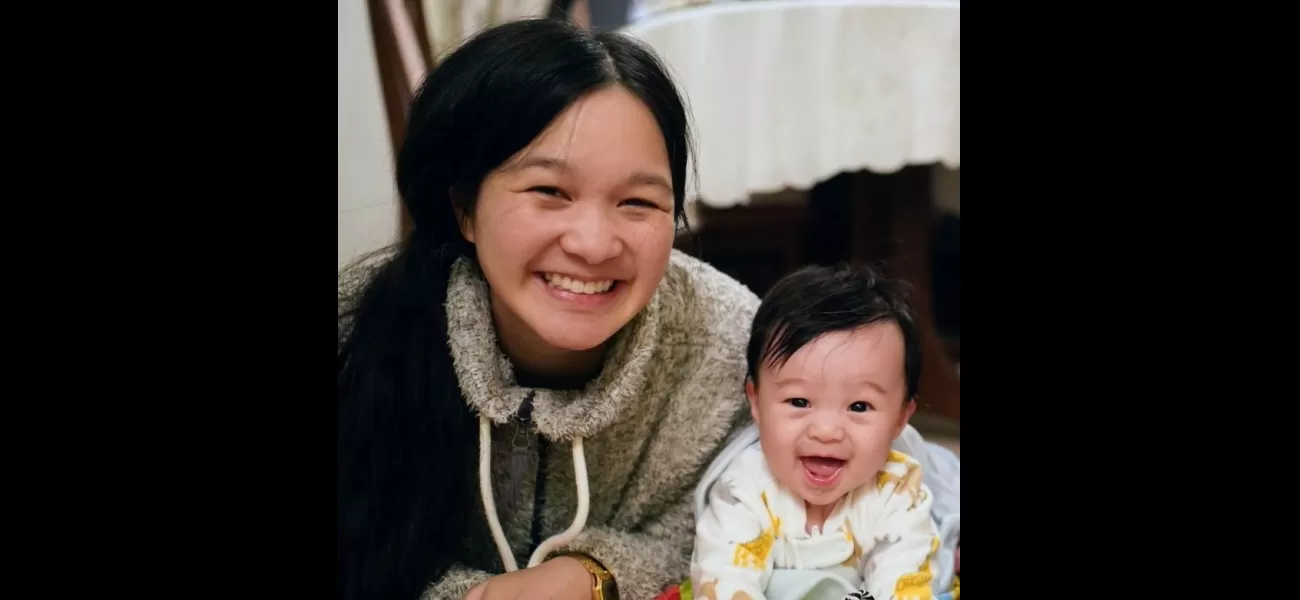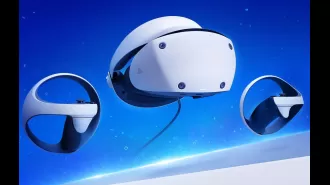I successfully trained my 5-month-old to use the bathroom, it wasn't difficult.
Developed regularity by spending time together regularly.
March 1st 2024.

Meet Alison Roberts-Tse, a 34-year-old mother from Maidstone who has accomplished a remarkable feat - potty training her baby boy, Ethan, at just five months old. While most parents begin potty training around the age of 18 months to two years, Alison has found success with her own unique approach.
Potty training can be a challenging process, and there is an abundance of advice and techniques available online. However, some parents continue to struggle even beyond the toddler years. In fact, according to a recent report from the charity Kindred, one in four children starting school are not yet toilet trained. This can lead to disruptions in the classroom, with teachers having to devote time to personal hygiene instead of lessons.
But Alison has found a way to make potty training a breeze - by using a method called 'Elimination Communication'. This approach teaches parents to pay attention to their baby's cues and signals to determine when they need to go to the toilet. Instead of using nappies, parents simply hold their little one over a toilet or potty, eliminating the need for diapers altogether.
"I came across EC before I even had my baby and was immediately intrigued," says Alison. "After reading about other families' positive experiences, I knew I wanted to give it a try." She started potty training Ethan when he was just three months old, as he was able to hold his head up and she had recovered from her emergency C-section.
While some parents use sinks or tubs for EC, Alison developed her own method. "I read some online guides to understand the basics and then started by having Ethan sit on the potty fully clothed, just to get used to the feeling. Then, I transitioned to having him sit on the potty with a bare bottom, and he had no trouble peeing in it from day one."
Alison also used sound and sign language cues to reinforce the experience and built up consistency with her son each day. "After he's done, it's a simple matter of disposing of the waste in the grown-up toilet and giving the mini potty a quick wash," she explains.
The results were almost instant, and Alison hasn't looked back since. "We don't catch every single pee in the potty, but Ethan has used the potty every single day since we started EC. And after just one month, he rarely soiled his nappies, and by two months, he had completely stopped. This was a huge relief when we took him on two 12-hour flights to visit family overseas!"
While many people use nappy-free time to observe if their little one needs to go to the bathroom, Alison developed her own technique. "I created a baby activity tracker in a digital calendar to record Ethan's potties and signals for when he needed to go. I also included any incorrect predictions and what he actually wanted in those instances."
Alison clarifies that EC is not a new fad. In fact, it was mentioned in the 1950s book, Teach Yourself Mothercraft, as the quickest way to potty train a baby. Last year, comedian Kathryn Ryan shared how she potty trained her son at just 8 months old and encouraged other parents to try it out.
However, not everyone was as enthusiastic about Alison's approach. "My loved ones were both supportive and skeptical," she shares. "Some said, 'It sounds great, I can't wait to hear about it!' while others were more reserved, saying 'That's really interesting, good luck with that.' They liked the theory, but weren't sure if it would be successful in practice."
Thankfully, Alison's husband was willing to give it a try, and after almost two months of solo pottying, he joined in when he saw the consistent success. "Throughout the first year and beyond, babies go through an average of 4000 nappies, so there's a waste factor to think about as well," says Alison. "By using EC, you won't use as many disposable nappies, which is not only good for your wallet but also for the environment."
Alison also believes that there are endless behavioral benefits to using EC. "It's another tool in the parenting 'toolbox'. If Ethan is feeling antsy or unsettled and I know he's not hungry, sleepy, too hot, or too cold, I can offer him the toilet as an option."
She adds, "Our baby also doesn't get painful nappy rash, and we don't have to worry about any 'poonamis'." While Ethan still wears a nappy in between using the potty, Alison is confident that these skills will serve him well in the future.
"We won't let an obsession with the potty get in the way of fun and other developmental skills," she says. "We simply communicate and tell him that his pee goes in the potty. Then we set him on the potty so he can empty his bladder completely. Even if his nappy is wet, there's a good chance he's still holding more."
Inspired by her success with EC, Alison has now created a course called 'Bare Bum Baby' to help other parents with potty training using this method. "I wasn't super confident at first, but I was open-minded," she shares. "I'm so glad we incorporated it into our lifestyle, and I'm proud that it's just a normal part of our daily routine now."
If you're interested in trying out EC with your little one, Alison encourages you to do your research and stay consistent. "It takes time and patience, but the results are worth it," she says. "And remember, every child is different, so what works for one may not work for another. But it's definitely worth giving it a try!"
Potty training can be a challenging process, and there is an abundance of advice and techniques available online. However, some parents continue to struggle even beyond the toddler years. In fact, according to a recent report from the charity Kindred, one in four children starting school are not yet toilet trained. This can lead to disruptions in the classroom, with teachers having to devote time to personal hygiene instead of lessons.
But Alison has found a way to make potty training a breeze - by using a method called 'Elimination Communication'. This approach teaches parents to pay attention to their baby's cues and signals to determine when they need to go to the toilet. Instead of using nappies, parents simply hold their little one over a toilet or potty, eliminating the need for diapers altogether.
"I came across EC before I even had my baby and was immediately intrigued," says Alison. "After reading about other families' positive experiences, I knew I wanted to give it a try." She started potty training Ethan when he was just three months old, as he was able to hold his head up and she had recovered from her emergency C-section.
While some parents use sinks or tubs for EC, Alison developed her own method. "I read some online guides to understand the basics and then started by having Ethan sit on the potty fully clothed, just to get used to the feeling. Then, I transitioned to having him sit on the potty with a bare bottom, and he had no trouble peeing in it from day one."
Alison also used sound and sign language cues to reinforce the experience and built up consistency with her son each day. "After he's done, it's a simple matter of disposing of the waste in the grown-up toilet and giving the mini potty a quick wash," she explains.
The results were almost instant, and Alison hasn't looked back since. "We don't catch every single pee in the potty, but Ethan has used the potty every single day since we started EC. And after just one month, he rarely soiled his nappies, and by two months, he had completely stopped. This was a huge relief when we took him on two 12-hour flights to visit family overseas!"
While many people use nappy-free time to observe if their little one needs to go to the bathroom, Alison developed her own technique. "I created a baby activity tracker in a digital calendar to record Ethan's potties and signals for when he needed to go. I also included any incorrect predictions and what he actually wanted in those instances."
Alison clarifies that EC is not a new fad. In fact, it was mentioned in the 1950s book, Teach Yourself Mothercraft, as the quickest way to potty train a baby. Last year, comedian Kathryn Ryan shared how she potty trained her son at just 8 months old and encouraged other parents to try it out.
However, not everyone was as enthusiastic about Alison's approach. "My loved ones were both supportive and skeptical," she shares. "Some said, 'It sounds great, I can't wait to hear about it!' while others were more reserved, saying 'That's really interesting, good luck with that.' They liked the theory, but weren't sure if it would be successful in practice."
Thankfully, Alison's husband was willing to give it a try, and after almost two months of solo pottying, he joined in when he saw the consistent success. "Throughout the first year and beyond, babies go through an average of 4000 nappies, so there's a waste factor to think about as well," says Alison. "By using EC, you won't use as many disposable nappies, which is not only good for your wallet but also for the environment."
Alison also believes that there are endless behavioral benefits to using EC. "It's another tool in the parenting 'toolbox'. If Ethan is feeling antsy or unsettled and I know he's not hungry, sleepy, too hot, or too cold, I can offer him the toilet as an option."
She adds, "Our baby also doesn't get painful nappy rash, and we don't have to worry about any 'poonamis'." While Ethan still wears a nappy in between using the potty, Alison is confident that these skills will serve him well in the future.
"We won't let an obsession with the potty get in the way of fun and other developmental skills," she says. "We simply communicate and tell him that his pee goes in the potty. Then we set him on the potty so he can empty his bladder completely. Even if his nappy is wet, there's a good chance he's still holding more."
Inspired by her success with EC, Alison has now created a course called 'Bare Bum Baby' to help other parents with potty training using this method. "I wasn't super confident at first, but I was open-minded," she shares. "I'm so glad we incorporated it into our lifestyle, and I'm proud that it's just a normal part of our daily routine now."
If you're interested in trying out EC with your little one, Alison encourages you to do your research and stay consistent. "It takes time and patience, but the results are worth it," she says. "And remember, every child is different, so what works for one may not work for another. But it's definitely worth giving it a try!"
[This article has been trending online recently and has been generated with AI. Your feed is customized.]
[Generative AI is experimental.]
0
0
Submit Comment





